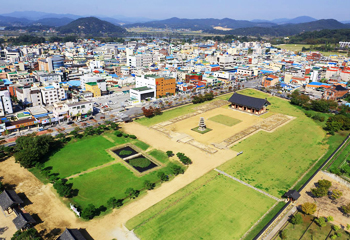Jeongnimsa Temple Site
Jeongnimsa Temple Site is located in flat land of the center of Buyeo. Geumseongsan Mountain stands to the east and Busosan Mountain stands to the north of the temple site. Jeongnimsa Temple was constructed in the central part of the capital city during the Sabi Period. The surface of the stone pagoda is engraved with Chinese characters celebrating the victory of the Tang Dynasty over Baekje, indicating the symbolic importance of its location for Baekje.
During the construction of Jeongnimsa Temple, the northeast area was lowered while the southwest area was raised up with earth to even out the topography according to archaeological evidences. This was done because the land was sloped from the northeast to the southwest. Also, the original topography of the southern and western part of the temple site was preserved. These areas are relatively lower than the temple site, and thus contributed to emphasizing the majesty of the temple site.

An archeological investigation of Jeongnimsa Temple Site confirmed the existence of the central gate site, prayer hall site, lecture hall site, and the sites of the monks’ dormitories in the north, east, and west, as well as the linking corridor sites. In particular, the layout of the monks’ dormitories attached to the corridors, was a unique feature found only in Baekje temples.
The central area of a temple generally consisted of a prayer hall that contained statues of Buddha, and a pagoda that enshrined Buddha’s sarira. The layout of the temple buildings was either a “one pagoda and one prayer hall” style or a “one pagoda and two prayer halls” style. Jeongnimsa Templewas a typical example that belonged to the first style, in which a pagoda and a prayer hall were placed in a line and surrounded by a lecture hall, the monks’ dormitories, and linking corridors. Also, archaeological excavations have revealed that the buildings that once stood on this site were wooden buildings constructed on tiled platforms.
The distance from the site of the northern monks’ dormitory to the central gate site was 107m. The width of entire temple site was 62m, from the outer boundary of the east to west building sites. In addition, two pond sites were discovered to the south of the central gate.
The temple site also has an 8.3m high five-story stone pagoda. This stone pagoda is well proportioned with a low platform and a high main body on its first story. In addition, the height and width of the main body on its second and higher stories were drastically reduced in order to direct one’s visual focus to the first story. On the first story of the main body, stone pillars were placed at the corners and each space between the pillars was filled with stone slabs, making it look like a gate with two doors. There is a thin roof stone on each story that is slightly sloped and raised at the end in order to maximize its artistic beauty.

The original appearance of the pagoda has remained nearly intact from the platform to the roofstone on the fifth story, but most of its ornamental finial at the upper extremity of the pagoda was lost, except for part of the ba
The main reason for the stability and aesthetic beauty of this stone pagoda can be found in its perfect proportions. According to the survey by Japanese architect Yoneda Miyoji, both height and width of first story are 7 cheok and the height of the platform is 3.5 cheok. Cheok is a measuring unit used in the old East Asia. One Cheok corresponds to approximately 30cm today. The stone pagoda was built according to the proportion of 7 cheok all around according to the principle of equal partition.
Various archaeological findings, including numerous roof tiles and clay figurines, were discovered at this temple site during excavations. Among them, the clay figurines are very similar to archaeological findings at Yeongning Temple, that was located in the capital city of the Northern Wei Dynasty of China, in terms of their shape and production method.










